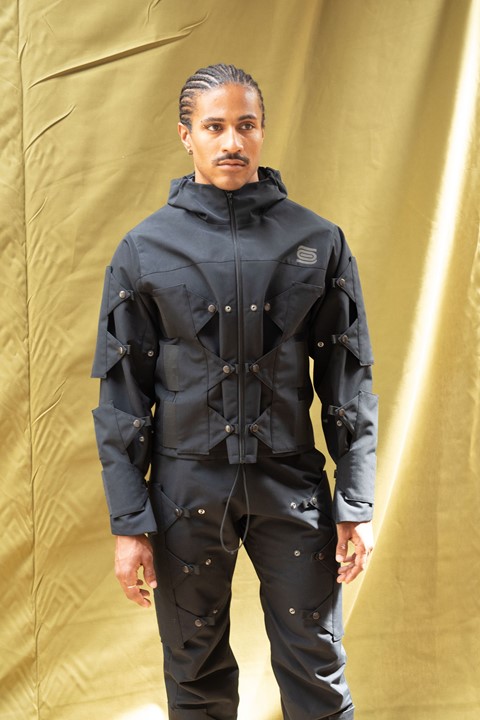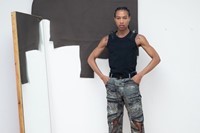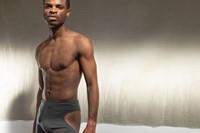The Central Saint Martins graduate and self-confessed “workwear freak” is challenging the hypermasculine tropes of techwear with his sensual, soft designs
- Who is it? The eponymous label of recent Central Saint Martins graduate Olly Shinder
- Why do I want it? Sensitive workwear-inspired garments crafted with an engineer-like precision
- Where can I find it? Coming soon
Who is it? Designer Olly Shinder is a self-confessed “workwear freak”. Sidestepping the big fashion houses, he spent his final year work placement for his BA in Fashion Design at Central Saint Martins assisting at Snickers, a leading Swedish technical wear brand that designs garments for construction workers. This unorthodox experience enabled the designer to resolve utility with fashion in an unprecedented way – as his recent graduate collection showcases. Following the acclaim the collection deservedly received, Shinder is now set to launch his namesake label.
London-born and raised, Shinder was drawn to fashion from a young age. “I went out to Vogue Fabrics when I was 16, even though I had a really early curfew,” he laughs. “I saw this nightlife, these people, this life, and I just knew that’s what I wanted.” Such prescience gave Shinder a headstart on his classmates; before starting university, the designer interned under Phoebe Philo at Céline and spent his time at school seeking experience with smaller, underground labels like GmbH and Nasir Mazhar.
But it was his geekish passion for workwear and utility gear, which spans beyond lite aesthetic references, that ultimately led Shinder to intern at Snickers. What he sought was a utilitarian, function-first understanding of design – how design can practically serve its wearer. Working within the construction industry also exposed him to a very pragmatic approach to sustainability: garments must be durable and silhouettes rarely change, even across genders. Design and production, as such, was slow, precise, and unrushed. Yet however formative the experience was, “it made me really miss the creative side of fashion and realise that I really am that: a designer for fashion, for culture, and for art,” says Shinder, “I’m not a tech designer, but I am inspired by it and I love it.”
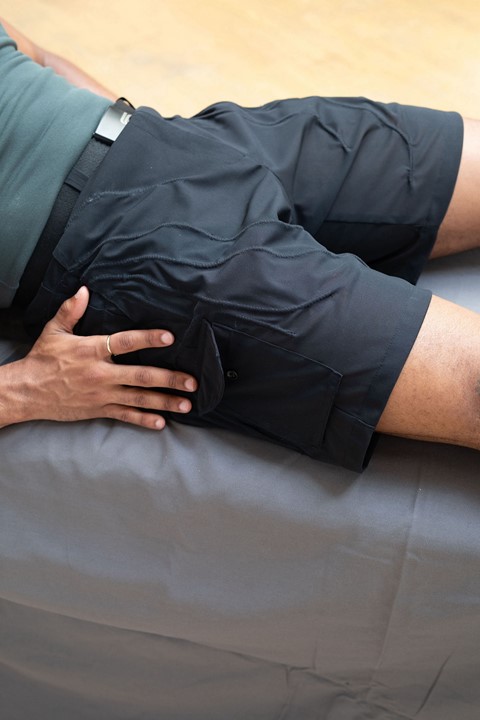
In this sense, Shinder’s graduate collection so masterfully embodies his personal resolve. “I had the luxury of not holding responsibility as a total function-driver but [I] could use the functions developed by workwear companies and then apply my designs on top of it,” he explains. By subverting the hard-edged forms and fabrics associated with techwear and workwear, the designer also challenges the hypermasculine, all-too-toxic tropes underpinning this world. Hiking trousers cut from silk, tight bum-cheekless underwear made in polar fleece and tracksuits crafted from bra contour net open this world up to one of softness, sensitivity, and queerness, where “this hypermasculine energy can be applied to people from all genders.”
Why do I want it? From the streamlined silhouettes of his designs to the engineer-like manipulation of fabrics and their associations, Shinder has transformed the rigid uniforms of workwear into strikingly sensitive yet storied garments. Fabric is juxtaposed with function and the designs are often surreptitiously invested with historical references.
Take, for example, his tracksuit made from bra contour net (used in corsets) and veined with elastic cord – a nod to the electric-heated flight suits worn by pilots which were structured with cables. Shinder almost disregards the conventional use of the fabric, allowing the material to sit loosely with a slight transparency to temper out the associated historical machismo of the suit.
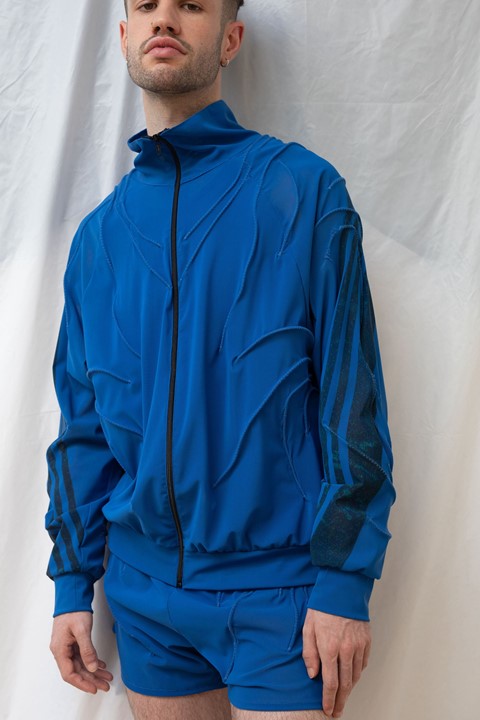
The collection is also the result of several collaborations which again personalise the often-sterile aesthetics of workwear. For his silk hiking trousers – to which the designer added a three-way zipper and lined with a gridded lace mesh – Shinder worked with print designer Nusra Nijimbere. Although the mottled marks of Nijimbere’s print recall a camouflage motif, the intimate design is a reflection on and record of a family’s history of displacement and settlement following the Burundi Civil War. In places where the pattern fades, the wearer’s skin fills the design and interweaves their story with that of both designers.
For the footwear, Shinder collaborated with The North Face, adapting a model of hiking shoes that he always liked and had worn for “their chunky feeling that somehow felt appropriate for wearing out, like a rave shoe.” Referencing historical rave shoes, the designer chunked the shoes out even further; he created a rubber tyre-like structure, inspired by intense outdoor climbing equipment, that is clamped by hand around the shoe.
The lookbook was shot by Wolfgang Tillmans and styled by Simon Gray. In his deceptively casual yet physical style, the German photographer documents the dexterity of Shinder’s designs and captures, more importantly, the designer’s sublime humility. Despite the myriad of references to workwear, techwear, rave culture and military history, the garments maintain a simplicity. And it is this talent, for making the intricately complicated seem aesthetically uncomplicated, that will propel the designer’s success.
Where can I find it? Coming soon.
